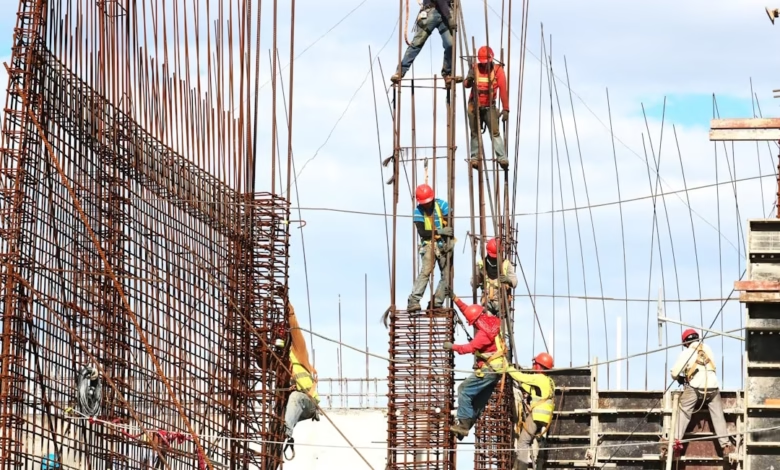The Essential Guide to Construction Metals: Understanding Steel, Aluminum, and Their Role in Sustainable Building Practices

In the ever-evolving landscape of construction, the choice of materials plays a pivotal role in determining the durability, sustainability, and overall success of any project. Among the various options available, construction metals such as steel and aluminum stand out as indispensable components in modern building practices. These industrial metals not only provide structural integrity but also adapt to innovations in design and technology, such as 3D printing metals and advanced metal fabrication techniques.
In this article, we will delve into the essential role of construction metals, exploring the differences between ferrous and non-ferrous metals and their applications within the industry. We will also highlight the growing importance of sustainable metal production and recycling, shedding light on how these practices impact metal trends and the future of construction materials. From base metals like copper and zinc to precious metals such as gold and silver, understanding the nuances of metallurgy is crucial for professionals in the field. Join us as we uncover the vital insights surrounding construction metals and their influence on a sustainable future in building infrastructure.
- 1. Understanding Construction Metals: The Role of Steel, Aluminum, and Other Key Materials
- 2. Exploring Ferrous and Non-Ferrous Metals: Essential Insights for the Construction Industry
- 3. Sustainable Metal Production and Recycling: The Future of Construction Metals and Their Impact on Metal Trends
1. Understanding Construction Metals: The Role of Steel, Aluminum, and Other Key Materials
The construction industry relies heavily on various metals to create durable and effective building materials. Understanding the role of construction metals, particularly steel, aluminum, and other key materials, is essential for anyone involved in building and design.
Steel, a ferrous metal, is one of the most widely used construction materials due to its strength and versatility. It is an essential base metal in structural applications, providing the framework for buildings, bridges, and other infrastructures. Its resistance to metal corrosion, when properly treated, makes it suitable for a variety of environments. Furthermore, steel's recyclability makes it a sustainable option, aligning with modern trends toward sustainable metal production.
Aluminum, a prominent non-ferrous metal, is also crucial in the construction sector. Known for its lightweight and corrosion-resistant properties, aluminum is frequently used in window frames, roofing, and siding. The use of aluminum in construction not only enhances energy efficiency but also contributes to the aesthetics of modern architecture. The growing interest in aluminum reflects broader metal trends, as it is increasingly utilized in innovative building designs.
In addition to steel and aluminum, various other industrial metals play significant roles in construction. Copper and zinc are vital for plumbing and roofing applications, while lithium and other battery metals are becoming increasingly important in energy-efficient construction projects, particularly in integrating renewable energy sources. The rise of 3D printing metals is also revolutionizing the industry, allowing for custom designs and reducing waste in the fabrication process.
Moreover, the construction sector is witnessing a growing emphasis on metal recycling. This practice not only conserves precious metals and rare earth metals but also reduces the environmental impact of metal mining. By reusing and recycling metals, the industry can lower its carbon footprint and promote sustainability.
In summary, the understanding of construction metals goes beyond mere selection; it encompasses a broader view of their environmental impacts, recyclability, and the interplay of metallurgy in creating innovative and sustainable building solutions. As the industry evolves, the importance of metals such as steel, aluminum, and others will continue to shape the future of construction.
2. Exploring Ferrous and Non-Ferrous Metals: Essential Insights for the Construction Industry
In the construction industry, understanding the distinction between ferrous and non-ferrous metals is crucial for selecting the right materials for various projects. Ferrous metals, which primarily consist of iron, are renowned for their strength and durability. Steel, a prominent ferrous metal, is widely used in structural applications due to its excellent tensile strength and versatility. However, one must also consider the potential for metal corrosion, particularly in environments exposed to moisture or corrosive substances. Implementing protective coatings and treatments can significantly enhance the longevity of ferrous materials in construction.
On the other hand, non-ferrous metals, such as aluminum, copper, and zinc, offer unique advantages that make them indispensable in construction. Aluminum is lightweight and resistant to corrosion, making it ideal for applications in building facades and roofing. Copper is not only aesthetically pleasing but also boasts excellent electrical and thermal conductivity, which is essential for electrical wiring and plumbing systems. Additionally, zinc is often used as a protective coating to prevent corrosion on steel structures.
The growing emphasis on sustainable metal production has led to increased interest in metal recycling, particularly with non-ferrous metals. Recycling metals not only conserves natural resources but also reduces energy consumption compared to traditional metal mining. Furthermore, with the rise of 3D printing metals, the industry is witnessing new possibilities in metal fabrication, allowing for the creation of complex structures with reduced waste.
It’s also worth noting the relevance of base metals and precious metals in the construction sector. While base metals like steel and aluminum form the backbone of construction materials, precious metals, such as gold and platinum, find niche applications in luxury building projects and specialized components. Gold investing and silver investing are often linked to the overall performance of metal commodities, which can influence the availability and pricing of these metals in the construction market.
As the industry evolves, staying informed about metal trends—including advancements in metallurgy and the integration of battery metals like lithium in sustainable building technologies—can provide construction professionals with a competitive edge. By understanding the properties and applications of both ferrous and non-ferrous metals, the construction sector can make informed decisions that enhance project outcomes while contributing to environmental sustainability.
3. Sustainable Metal Production and Recycling: The Future of Construction Metals and Their Impact on Metal Trends
The construction industry is experiencing a significant shift towards sustainable metal production and recycling, which is reshaping the landscape of construction metals. As concerns about environmental impact grow, the focus on using metals in a responsible manner has become paramount. Sustainable practices in metal mining and metallurgy not only reduce the ecological footprint but also enhance the overall lifecycle of metal commodities used in construction.
Metal recycling plays a crucial role in this transition. By reusing ferrous and non-ferrous metals such as steel, aluminum, copper, and zinc, the industry can significantly decrease the demand for virgin materials. Recycling not only conserves resources but also minimizes energy consumption associated with metal fabrication. For instance, recycled aluminum requires 95% less energy to produce than new aluminum, making it an attractive option for sustainable construction practices.
The rise of advanced technologies, including 3D printing metals, is also influencing the future of construction metals. This innovative method allows for the efficient use of metal alloys, reducing waste while enabling the creation of complex structures that traditional methods cannot achieve. Additionally, with the increased interest in energy metals like lithium and palladium for emerging technologies, recycling these precious metals and rare earth metals can support both the construction and technological sectors.
As the demand for sustainable building materials grows, the construction industry is likely to see a rise in the use of refractory metals and automotive metals in innovative applications. This trend will not only enhance the durability and performance of construction materials but also address issues related to metal corrosion, ensuring longevity and reliability in infrastructure.
Investing in sustainable metal production practices is essential for the future of construction. By prioritizing metal recycling and innovative production methods, the industry can adapt to changing market demands while minimizing environmental impact. This approach not only aligns with global sustainability goals but also opens new avenues for investment in metal commodities, including gold investing and silver investing, as the focus shifts toward responsible sourcing and production.
In conclusion, the future of construction metals lies in sustainable practices that embrace recycling, innovative fabrication techniques, and the efficient use of both base metals and precious metals. As the industry evolves, staying attuned to these metal trends will be crucial for companies looking to thrive in a competitive and environmentally-conscious marketplace.
In conclusion, the landscape of construction metals is vast and multifaceted, encompassing a variety of materials that play critical roles in building and infrastructure development. Understanding the differences between ferrous and non-ferrous metals is essential for industry professionals, as it influences decisions related to metal selection, fabrication, and overall project sustainability. As we move towards a future that prioritizes sustainable metal production and recycling, the construction industry must adapt to emerging metal trends, including the increasing importance of base metals like aluminum, copper, and zinc, as well as precious metals like platinum and palladium.
The integration of advanced technologies such as 3D printing metals is reshaping how we approach metal fabrication, allowing for innovative designs and efficient use of resources. Additionally, the focus on metal recycling not only aligns with global sustainability goals but also addresses the growing demand for rare earth metals and battery metals, crucial for industries beyond construction, including automotive and aerospace.
As we continue to explore the potential of industrial metals, it is vital to consider the broader implications of metal mining and metallurgy on the environment and economy. Investment in metals, whether for construction or other applications such as jewelry or energy, requires a careful balancing of economic benefit and ecological responsibility. By prioritizing sustainable practices and embracing new technologies, the construction industry can lead the way in utilizing metals responsibly, ultimately contributing to a more sustainable future.
References:
– [Insert relevant sources here]





